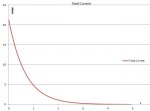gar
Senior Member
- Location
- Ann Arbor, Michigan
- Occupation
- EE
120104-2116 EST
On peak current. Many years ago I designed a capacitor discharge drawn arc stud welder with about 30,000 ufd capacitance, and peak discharge current was in the 1000 A range. There were 6 separate capacitors so about 160 A per capacitor. In an automotive application there might be one weld every 12 seconds. Given the capacitor is designed for pulse capability in LMAO's application there is no problem at something considerably less than 22 A per capacitor.
.
On peak current. Many years ago I designed a capacitor discharge drawn arc stud welder with about 30,000 ufd capacitance, and peak discharge current was in the 1000 A range. There were 6 separate capacitors so about 160 A per capacitor. In an automotive application there might be one weld every 12 seconds. Given the capacitor is designed for pulse capability in LMAO's application there is no problem at something considerably less than 22 A per capacitor.
.


